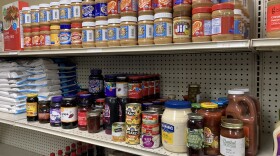The City of Milwaukee is putting the finishing touches on a water and land use plan to help guide the future of the harbor’s 1,000 water-edged acres. The idea is to combine a robust working function while also breathing vitality into areas where there currently is none.

Lots of ideas are floating around.
Enter a New-York based artist by the name of Mary Miss. She uses the environment in unexpected and artful ways to draw people to outdoor spaces.
Miss was trained as a sculptor and says she aims to reshape the boundaries between sculpture, architecture, landscape design and installation art.

She designed South Cove Park on the Hudson River in the mid 1980s, and it remains one of her hallmark projects.
In the 1990s, Miss came to know Milwaukee and its waters when she was asked to contribute to the design of Milwaukee’s Riverwalk. She recently returned to Milwaukee to take a fresh look, this time with the Harbor District as her pallet.
Watermarks Project
Miss envisions a project she calls Watermarks: An Atlas Of Water And The City Of Milwaukee. She has teamed up with Marquette University's Haggerty Museum of Art and received a 2016 strategic innovation grant to fine tune the design.
She would affix large letters to existing stacks or poles in the area. Each would symbolize a bit of Milwaukee's water story, with more information available through an app.

"One of the first one's we're going to put up is going to be up is at the corner of Greenfield and 1st Street where (UW-Milwaukee architecture professor) Jim Wasley has been working on a fountain that takes the roof water and cleans it," Miss explains.
Next to the fountain, Miss wants to place a letter on a 25-foot pole. The letter might be "G" for green infrastructure.
"The character (letter) itself will be lit, but about 10 feet of the pole itself is wrapped in photovoltaic skin so we don't have to get energy from the city. Each will be independent," she says.
A bench would be attached to the base of the pole. "And on that bench it's telling you that G is for green infrastructure, but then it gives you the app address. You can go to that app and hear Jim talk about what this it, how it works," Miss says.
She hopes the app will cultivate conversation within the community and allow people to share their own stories in return.
"We want to give people information about each of these sites, but then we also want to start to collect the response from people around there. Who remembers this spot before it was this nice apartment complex," Miss says for example. "Someone says, 'My father used to work in the foundry that was here.'"
Adding An Artist's Touch
Miss hopes the mission of the nonprofit she created can be implemented in Milwaukee. City As Living Laboratory, or CALL, aims to add an artist's eye to the natural and the man-made in communities.
"People still don't get it - what could an artist do? And I'm saying, through my city-as-living-lab work, artists are a tremendous resource throughout a community."
"Artists are a tremendous resource within a community.....Imagination is our territory," she explains. "How can that imagination be focused on allowing people to understand how they're supported by the infrastructure of the city, what is their relationship to the natural system."
Miss says the idea is not to tell people what they should know or think, rather, "Get their interest, hear their experiences, build off what they know better than anybody else about their neighborhoods."
She says each element of Watermarks would send a message she hopes people will respond to.
She envision the 300-foot-tall stack on Jones Island as the project's icon.

"There would be a big character, W is for water, but if it's going to rain the next day, it will turn red. Everybody can turn on the radio or go to the phone to see if it's going to rain, but the idea is to try to spread this idea of how you as an individual by not using your bathtub or dishwasher, your heavy uses of of water, the night before a rain, your household can be part of the green infrastructure of the city." Miss adds, "You know if 50,000 households in Milwaukee each saved 25 gallons of water that would be a substantial amount of water that doesn't have to be an overflow into the lake."
Miss' vision is expansive. She imagines Watermarks installations throughout the city.
For now though, she's focusing on cultivating funding and making sure the Watermarks' app is topnotch, "because no one will know what this is about without the app."





